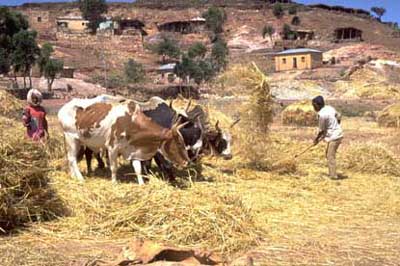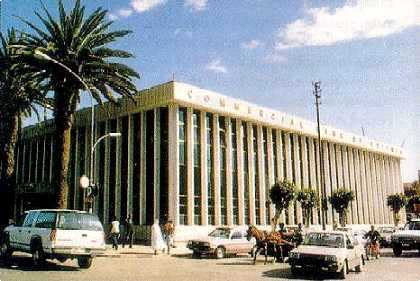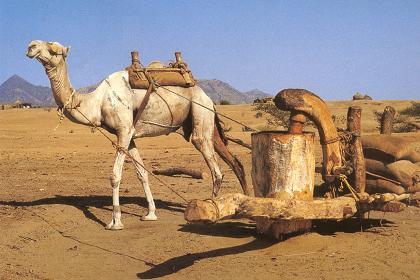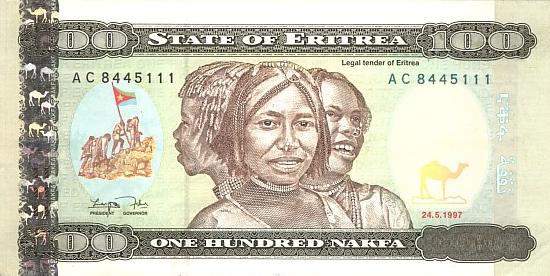Map of Eritrea
Location and geography
Eritrean history
Border conflict with Ethiopia
Political structure
Eritrean anthem
Economy & currency
Climate
People
Languages
Religion
Health care
Transport
Cuisine
News, links, books and more
Asmara (Asmera)
Agordat (Akordat)
Assab (Asseb)
Barentu
Dahlak islands
Dekemhare (Decemhare)
Ghinda (Ginda)
Keren (Cheren)
Massawa (Massauwa)
Mendefera (Adi Ugri)
Nakfa (Nacfa)
Semenawi Bahri (Filfil)
Tessenei
(Teseney)
Economy of Eritrea
Thirty years of war has left the country totally devastated. The task of reconstruction is enormous. Eritrea is one of the poorest countries in the world. Most of the population live a subsistence lifestyle, supported by aid imports.
But there is no lack of determination. The Eritreans have always had a justified reputation for being industrious, and their determination to rebuild the country, so clearly visible, is matched by their courage in winning their freedom against massive odds.
A fundamental principle of the national development program is 'progress through self-reliance'. Eritrea has never accepted any aid that had conditions attached..

Each student carries a stone down to help build
dormitories, clinics, etc. (Nacfa Eritrea 1987)
1994 marked the beginning of a large-scale demobilization program, affecting roughly 60% of the military who are now involved in reconstruction. Reconstruction of the agricultural sector has been hampered by the legacy of war (damage to the land, mines and lack of equipment) and poor rainfall.
The National Service, announced on July 14th 1994 requires all women and men over eighteen to undergo six months of military training and a year of work on national reconstruction. This helped to compensate for the country's lack of capital and to reduce dependence on foreign aid, while welding the diverse society. Almost 40,000 people were called upon annually in a campaign to build new infrastructure. National service teams have constructed dams and wells, repaired roads, terraced hillsides to stop erosion, and planted millions of tree seedlings.
Eritrea's short-term prospects depend on outside aid and foreign investment, which prior to the 1998 Ethiopian aggression, had started to trickle in. Although Eritrea is in dire need of economic aid, the government practices great caution in accepting any form of help. It will refuse offers that come with strings attached or unreasonable conditions that may pose threat to the country's hard-won freedom.
Defense expenditures took up more than 25% of Eritrea's gross domestic product in 1997. This is a substantial amount for one of the worlds poorest countries, only justified by recent Ethiopian aggression. The pace of development is now dependent on the outcome of the conflict with Ethiopia. The Eritrean Ethiopian conflict has already cost Ethiopia and Eritrea many tens of thousands of casualties and is the primary cause of the fact that the economies of both countries remain among the least developed in the world..
Eritrea has inherited the entire coastline of Ethiopia. The country's territorial waters are almost half of its land area. Eritrea has long-term prospects for revenues from the development of offshore oil, offshore fishing and tourism.
Eritrea is located at the highest landmass of the African continent. As a result the highlands of Eritrea have ameliorating climate conditions. Resulting from these climatic conditions at higher altitudes we find vegetative cover and fertile soils which are suitable for agricultural purposes.
"Asara" traditional sesami oil press - Eritrea (© Saied Ibrahim Yehdego).
Land use:
Arable land (12%)
Permanent crops, coffee (1%)
Meadows and pastures (48%)
Forest and woodland (19%)
Other (20%)(2004 estimate)Irrigated land: 250 sq km (2004 estimate)
Natural hazards: frequent droughts, locust attacks on crops. During the recent war, Ethiopia looted cattle, goats and other livestock, and burnt agricultural land, contributing to Eritrean agricultural difficulties.
Main agricultural products (12.5% of GDP in 2004): Millet, sorghum, taff, wheat, barley, flax, cotton, coffee, tobacco, papayas, citrus fruits, bananas, beans and lentils, maize, potatoes, vegetables, sisal, edible oils, cut flowers, livestock (including goats), skins, meat, dairy products, fish.

Farmers tending cattle (© Eritrea - Hilfswerk in Deutschland)
Mineral reserves:
Salt, gold, silver, potash, sulfur, gypsum, feldspar, silica sand, copper, lead, zinc, iron ore, granite, marble, limestone, oil and natural gas.
Major industries (26% of GDP in 2004):
Cement, construction, salt, paper, matches, candles, food processing, dairy products, alcoholic beverages, leather products, textiles and clothing, chemicals.
Trade:
Exports (2004) $64.5 million: skins, meat, live sheep, and cattle, textiles, footwear, salt, fish, gum Arabic (mainly to Ethiopia, Saudi Arabia and Italy).
Imports (2004) $622 million: foodstuff, manufactured goods, machinery, building materials, petroleum products and transportation equipment
(mainly from Saudi Arabia, Ethiopia, Italy, UAE).Energy:
At present, wood and brushwood are among the major fuels. Eritrea does however have substantial hydro-electric power generating capacity.
Gross domestic product: $4,154 million (2004 estimate)
Annual growth rate (2004 est.): 2.5%
GDP per capita: $900 (2004 estimate)
Central government budget (2004): $375 million
Average inflation rate: 10% (2004 est.)
Official exchange rate: 15 Nakfa = one US$ (February 2017)
In 1997 Eritrea introduced its own currency, the Nakfa.
Tourism:
Sitting along the Red Sea coast, Eritrea is a historical place with fascinating scenery. Its coast-line provides recreational facilities which include exquisite unspoiled beaches, islands and marine parks, sport fishing, sailing, scuba diving, mountain hiking opportunities, camping grounds, hot springs, spas, wildlife and deserts. Many of Eritrea's historical sites and buildings are of international architectural importance and are being reserved as a national heritage. Eritreans are friendly, hospitable and honest, which makes Eritrea a delightful place to visit.
Human resources
Two highly commendable features: industriousness and steadfastness, characterize the people of Eritrea. Eritrea is a particularly favorable area for businessmen interested in a honest, disciplined, stable, cheap and willing labor force. The government of Eritrea is investing heavily on human resources development, for it believes that one of its best resources is its people. Thus, the people will play a significant role in the economic development of Eritrea.
Diaspora:
Remittances from overseas Eritreans, coupled with local tourism by those who return for visits, are Eritrea's main source of foreign exchange. These remittances are estimated at US$ 250 million per annum and include the voluntary 2% income tax, fundraising projects, personal donations and the purchasing of interest-free bonds.

Commercial Bank of Eritrea (Asmara)
| Table 1 Human development Index | ||||||||||
| HDI rank (of 177) | Human development index (HDI) value 2003 | Life expectancy at birth (years) 2003 |
Adult literacy rate (% age 15 and above) 2003 |
Combined primary, secondary and tertiary gross enrolment ratio (%) 2003 | GDP per capita (PPP US$) 2003 | Life expectancy index | Education index | GDP index | GDP per capita (PPP US$) rank minus HDI rank | |
| 1 | Norway | 0.963 | 79.4 | ..... | 101 | 37,670 | 0.91 | 0.99 | 0.99 | 2 |
| 77 | Saudi Arabia | 0.772 | 71.8 | 79.4 | 57 | 13,226 | 0.78 | 0.72 | 0.82 | -33 |
| 119 | Egypt | 0.659 | 69.8 | 55.6 | 74 | 3,950 | 0.75 | 0.62 | 0.61 | -10 |
| 141 | Sudan | 0.512 | 56.4 | 59.0 | 38 | 1,910 | 0.52 | 0.52 | 0.49 | -6 |
| 150 | Djibouti | 0.495 | 52.8 | 65.5 | 24 | 2,086 | 0.46 | 0.52 | 0.51 | -18 |
| 154 | Kenya | 0.474 | 47.2 | 73.6 | 52 | 1,037 | 0.37 | 0.66 | 0.39 | 7 |
| 161 | Eritrea | 0.444 | 53.8 | 56.7 | 35 | 849 | 0.48 | 0.49 | 0.36 | 7 |
| 170 | Ethiopia | 0.367 | 47.6 | 41.5 | 36 | 711 | 0.38 | 0.40 | 0.33 | 1 |
| 177 | Niger | 0.281 | 44.4 | 14.4 | 21 | 835 | 0.32 | 0.17 | 0.35 | -8 |
| Table 2 Human Development Index trends | ||||||||
| HDI rank (of 177) | 1975 | 1980 | 1985 | 1990 | 1995 | 2000 | 2003 | |
| 1 | Norway | 0.868 | 0.888 | 0.898 | 0.912 | 0.936 | 0.956 | 0.9363 |
| 77 | Saudi Arabia | 0.603 | 0.659 | 0.673 | 0.708 | 0.741 | 0.762 | 0.772 |
| 119 | Egypt | 0.439 | 0.487 | 0.540 | 0.579 | 0.611 | ..... | 0.659 |
| 141 | Sudan | 0.349 | 0.376 | 0.396 | 0.428 | 0.465 | 0.500 | 0.512 |
| 150 | Djibouti | ..... | ..... | ..... | ..... | 0.477 | 0.487 | 0.495 |
| 154 | Kenya | 0.461 | 0.509 | 0.530 | 0.546 | 0.524 | 0.499 | 0.474 |
| 161 | Eritrea | ..... | ..... | ..... | ..... | 0.409 | 0.428 | 0.444 |
| 170 | Ethiopia | ..... | ..... | 0.291 | 0.311 | 0.323 | 0.352 | 0.367 |
| 177 | Niger | 0.236 | 0.252 | 0.242 | 0.249 | 0.256 | 0.271 | 0.281 |
| Human development Index | ||||||||||
| HDI rank (of 177) | (3) Human income and poverty |
(7) water and nutritional status |
(28) female economic activity rate (age 15 and above) |
health indicators | ||||||
Human poverty index rank (of 103) |
Adult iliteracy rate (% age 15 and above) 2003 |
Population with access to an improved water source % | Population under- nourished | rate (%) 2003 | as % of male rate 2003 | (6) doctors (per 100.000 people) |
(6) public expenditure on health as % of GDP 2002 |
(9) % HIV/AIDS (adults 15-49) 2003 |
||
| 1 | Norway | ..... | ..... | 100 | ..... | 60.3 | 86 | 356 | 8.0% | 0.1% |
| 77 | Saudi Arabia | 32 | 20.6 | 90 | 3 | 22.4 | 29 | 140 | 3.3% | ..... |
| 119 | Egypt | 55 | 44.4 | 98 | 4 | 36.0 | 46 | 212 | 1.8% | < 0.1% |
| 141 | Sudan | 59 | 41.0 | 69 | 32 | 35.7 | 42 | 16 | 1.0% | 2.3% |
| 150 | Djibouti | 53 | 34.5 | 80 | ..... | 13 | 3.3% | ..... | ||
| 154 | Kenya | 64 | 26.4 | 62 | 44 | 74.7 | 85 | 13 | 2.2% | 6.7% |
| 161 | Eritrea | 73 | 33.2 | 57 | 73 | 74.5 | 87 | 3 | 3.2% | 2.7% |
| 170 | Ethiopia | 99 | 58.5 | 22 | 46 | 57.2 | 67 | 3 | 2.6% | 4.4% |
| 177 | Niger | 103 | 85.6 | 46 | 34 | 69.3 | 75 | 3 | 2.0% | 1.2% |
 Eritrea - Hilfswerk in Deutschland (EHD)
e.V.
Eritrea - Hilfswerk in Deutschland (EHD)
e.V.

